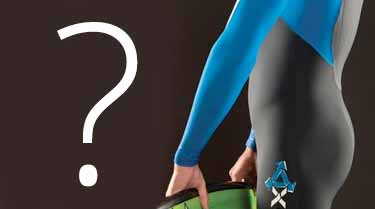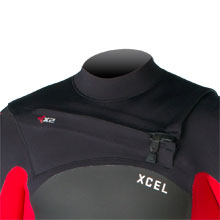
At Triocean Surf we are proud to stock wetsuits from a range of wetsuit suppliers such as Xcel Wetsuits, C-Skins Wetsuits, Saltskin Wetsuits and Zone 3 Wetsuits; but what are all these words you see about panels and x-zip entry systems?
When buying a wetsuit there are many things to think about, we’ve outlined below 3 important elements to consider.
The thickness of wetsuits is important in determining when the suit can be used and in which water temperatures.
As a general rule, June through to October in the Southwest of the UK is warm enough for a 3/2mm wetsuit. The water temperature at this time ranges from around 14C°-18C°. Above these temperatures, you will only require shortie wetsuits. For those lucky enough to surfing in temperatures above 22C° you will not even need a wetsuit, just a rash vest and board shorts.
November through to May will require a thicker wetsuit; a 5/4mm is the most common. In the depths of winter, you will need wetsuit accessories such as a wetsuit hood, wetsuit boots and wetsuit gloves.
 In basic terms, less seam means more stretch. One panel of neoprene has more stretch than two joined together with a stitched seam line.
In basic terms, less seam means more stretch. One panel of neoprene has more stretch than two joined together with a stitched seam line.
With fewer panels, you have less stitching and joining of these panels. This reduces the amount of cold water entering the suit and hot water leaving through the seams, which in turn leads to a warmer suit.
Entry-level wetsuits are made up of smaller panels stitched together, whereas top end wetsuits are made with fewer panels.
The type of neoprene used in the make up of the wetsuit is another factor for stretch – you may have heard the phrase “100% ultrastretch neoprene”. This means that the neoprene used will stretch to 100% of its original size. In basic wetsuits, this neoprene may just be used around the shoulders where the most stretch is needed. In high-performance wetsuits, this neoprene is used for most, if not all the wetsuit.
You may notice the chest and back panels of wetsuits are different in appearance to the rest. These panels are textured rubber, with lots of air trapped in the neoprene. This gives the panels extremely good wind resistance and is why they are used in the main, large panels. They are also used for such wetsuit accessories such as hoods.
 Wetsuit entry and zip construction has improved drastically in the last few years with virtually all top-end wetsuits having what is called a neck entry or chest zip. Unlike the older style back zip, which is still used in more basic wetsuits, the chest zip gives the user entry to the wetsuit through the neck and the head portion is pulled over at the end, before finally zipping across the chest.
Wetsuit entry and zip construction has improved drastically in the last few years with virtually all top-end wetsuits having what is called a neck entry or chest zip. Unlike the older style back zip, which is still used in more basic wetsuits, the chest zip gives the user entry to the wetsuit through the neck and the head portion is pulled over at the end, before finally zipping across the chest.
The chest zip wetsuits are slightly more difficult to get on than a back zip, however offer un-rivalled stretch and decreased water entry through the zip. The chest zip is the favourite entry system of all the staff at Triocean Surf.
Get Involved